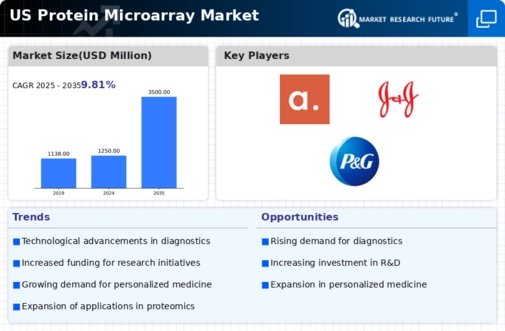Expansion of Research Funding
In recent years, there has been a marked increase in research funding from both public and private sectors, which is positively impacting the protein microarray market. Government agencies and private organizations are investing heavily in life sciences research, with funding allocations reaching upwards of $40 billion annually in the US. This influx of capital enables researchers to explore new applications of protein microarrays, particularly in drug discovery and development. As a result, the protein microarray market is likely to see enhanced innovation and product development, as well as increased adoption of these technologies in academic and commercial laboratories. The sustained financial support for research initiatives suggests a promising future for the protein microarray market.
Growing Focus on Disease Prevention
The protein microarray market is benefiting from a growing emphasis on disease prevention and early detection strategies. As healthcare systems increasingly prioritize preventive measures, the demand for diagnostic tools that can identify potential health risks is rising. Protein microarrays offer a high-throughput solution for screening multiple biomarkers simultaneously, making them invaluable in preventive healthcare. The market for diagnostic tools is expected to reach $100 billion by 2027, with protein microarrays playing a pivotal role in this growth. This trend indicates that the protein microarray market is well-positioned to capitalize on the shift towards proactive healthcare, as stakeholders seek efficient and effective methods for disease prevention.
Rising Demand for Biomarker Discovery
The protein microarray market is experiencing a notable surge in demand driven by the increasing need for biomarker discovery in various diseases. As healthcare shifts towards precision medicine, the identification of specific biomarkers becomes crucial for effective diagnosis and treatment. The market for biomarker discovery is projected to grow at a CAGR of approximately 12% over the next five years, indicating a robust opportunity for the protein microarray market. This growth is further fueled by advancements in proteomics and genomics, which enhance the capabilities of protein microarrays in identifying disease-specific biomarkers. Consequently, the protein microarray market is positioned to benefit significantly from this trend, as researchers and clinicians seek innovative solutions to improve patient outcomes through targeted therapies.
Integration of Artificial Intelligence
The integration of artificial intelligence (AI) into the protein microarray market is emerging as a transformative driver. AI technologies are being utilized to analyze complex data generated from protein microarrays, enabling researchers to derive insights that were previously unattainable. This integration enhances the accuracy and efficiency of data interpretation, which is crucial for advancing research in proteomics. The AI market in healthcare is projected to grow to $36 billion by 2025, suggesting a significant opportunity for the protein microarray market to leverage these advancements. As AI continues to evolve, its application in protein microarrays could lead to breakthroughs in understanding disease mechanisms and developing novel therapeutic strategies.
Increased Adoption in Clinical Diagnostics
The protein microarray market is witnessing increased adoption in clinical diagnostics, driven by the need for rapid and accurate testing methods. Healthcare providers are increasingly utilizing protein microarrays for various applications, including autoimmune disease diagnosis and infectious disease detection. The clinical diagnostics market is expected to grow at a CAGR of 10% over the next five years, indicating a strong demand for innovative diagnostic solutions. This trend suggests that the protein microarray market is likely to expand as healthcare systems seek to improve diagnostic accuracy and patient care. The ability of protein microarrays to provide comprehensive data in a single assay positions them as a valuable tool in the evolving landscape of clinical diagnostics.














Leave a Comment